Life Cycle Assessment of Residential Air Conditioners Considering the Benefits of Their Use: A Case Study in Indonesia
Abstract
1. Introduction
2. Materials and Methods
2.1. Air-Conditioner
2.2. Electricity Mix
2.3. LIME3
2.4. Cost–Benefit
- -
- Cost = External cost associated to air conditioner installation.
- -
- Benefit = Health effects reduction by introducing air conditioners (sleeping difficulty)
- -
- Cost-benefit ratio = Benefit/Cost (B/C).
2.4.1. Cost
2.4.2. Benefit
- (1)
- A coupled urban canopy meteorological-building energy model (CM-BEM) [29] was used to estimate the temperature and AC electricity consumption. The CM-BEM is composed of two entities: a canopy model (CM) that can simulate weather conditions in a city block (grid) consisting of several buildings, and a building energy model (BEM) that simulates heat loads and energy consumption based on heat transfers in buildings. The model’s output is provided at the grid-scale level (each grid is about 1.2 km2) for the Jakarta metropolitan area (total of 15,525 grids). The model was used to estimate the change in temperature at 10 p.m. for each grid when air conditioner usage increases, as shown in Figure 5.
- (2)
- The CM-BEM model’s output was linked to two damage functions of sleep difficulty, under AC usage and under no AC usage, and by taking the weighted mean of sleeping difficulty prevalence rates based on different AC usage rates (15% and 90%), the daily sleep disturbance prevalence for each grid was calculated.
- (3)
- As a unit to quantify damages, we used disability-adjusted life year (DALY); DALY is calculated as the sum of years of life lost (YLL) and years lost due to disability (YLD). Sleep disturbance is not a direct cause of death; therefore, only YLD was considered. The number of incidence cases in Jakarta obtained in step 2 was used to estimate the YLD. For the disability weight for sleep disturbance, we referred to Fukuda et al. [30].
- (4)
- The DALY from sleeping difficulty when the AC usage rate is 15% and 90% was calculated (33,728 and 21,552 DALYs, respectively).
- (5)
- Monthly sleeping difficulty reduction effect per one AC unit was calculated by dividing the difference in the DALY from sleeping difficulty (the results per grid are shown in Figure 6) by the difference in the number of ACs in both usage scenarios (6,315,519 and 37,893,113 units for 15% and 90% usage rates, respectively).
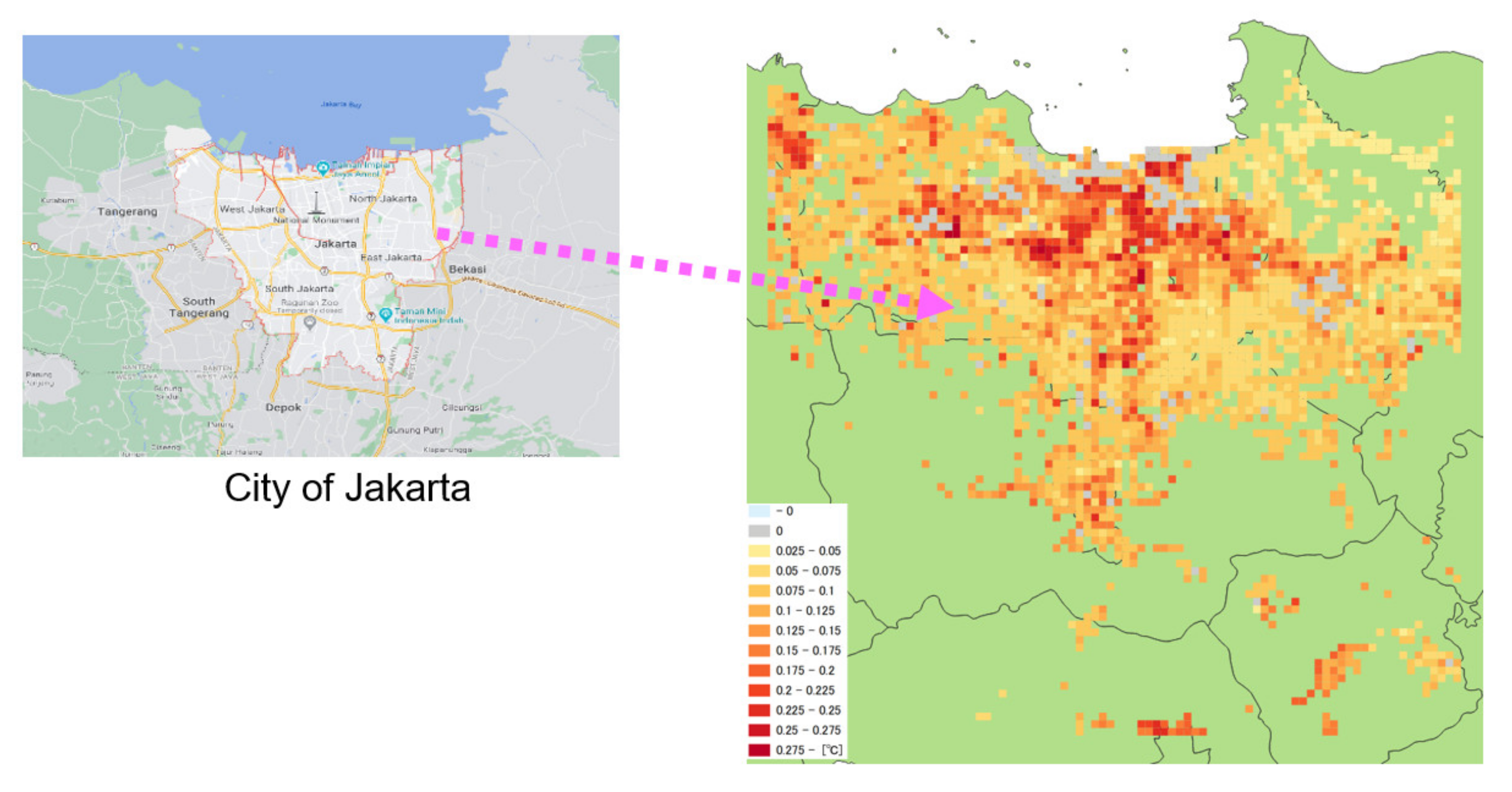
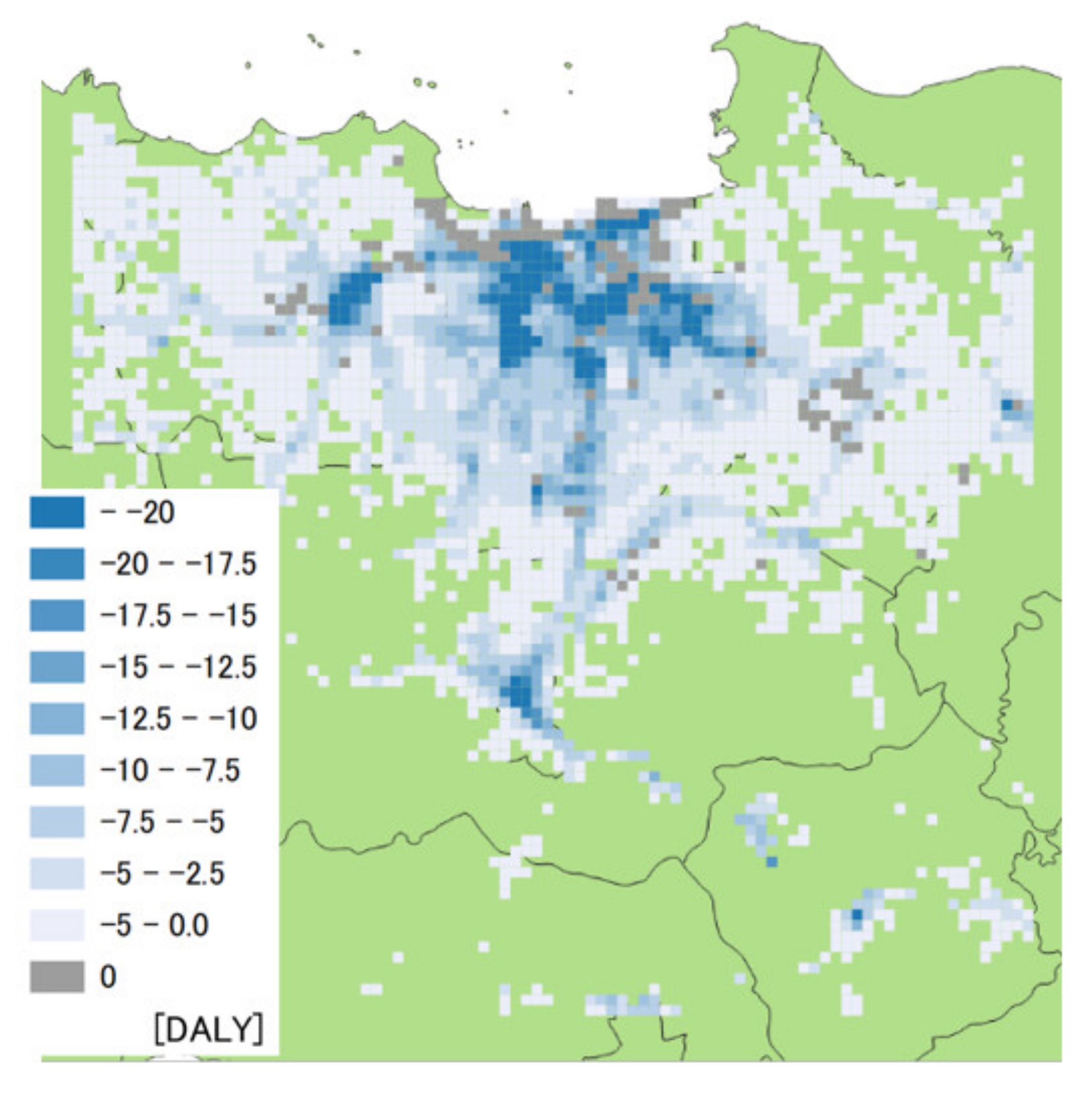
3. Results
3.1. Midpoint Characterization
3.2. Integration
3.3. Cost-Benefit Analysis
4. Discussion
4.1. Climate Change and Air Pollution
4.2. Resource Consumption
4.3. Importance of Inverter vs. Choice of Refrigerant
4.4. Future Tasks
5. Conclusions
Author Contributions
Funding
Institutional Review Board Statement
Informed Consent Statement
Data Availability Statement
Acknowledgments
Conflicts of Interest
Appendix A

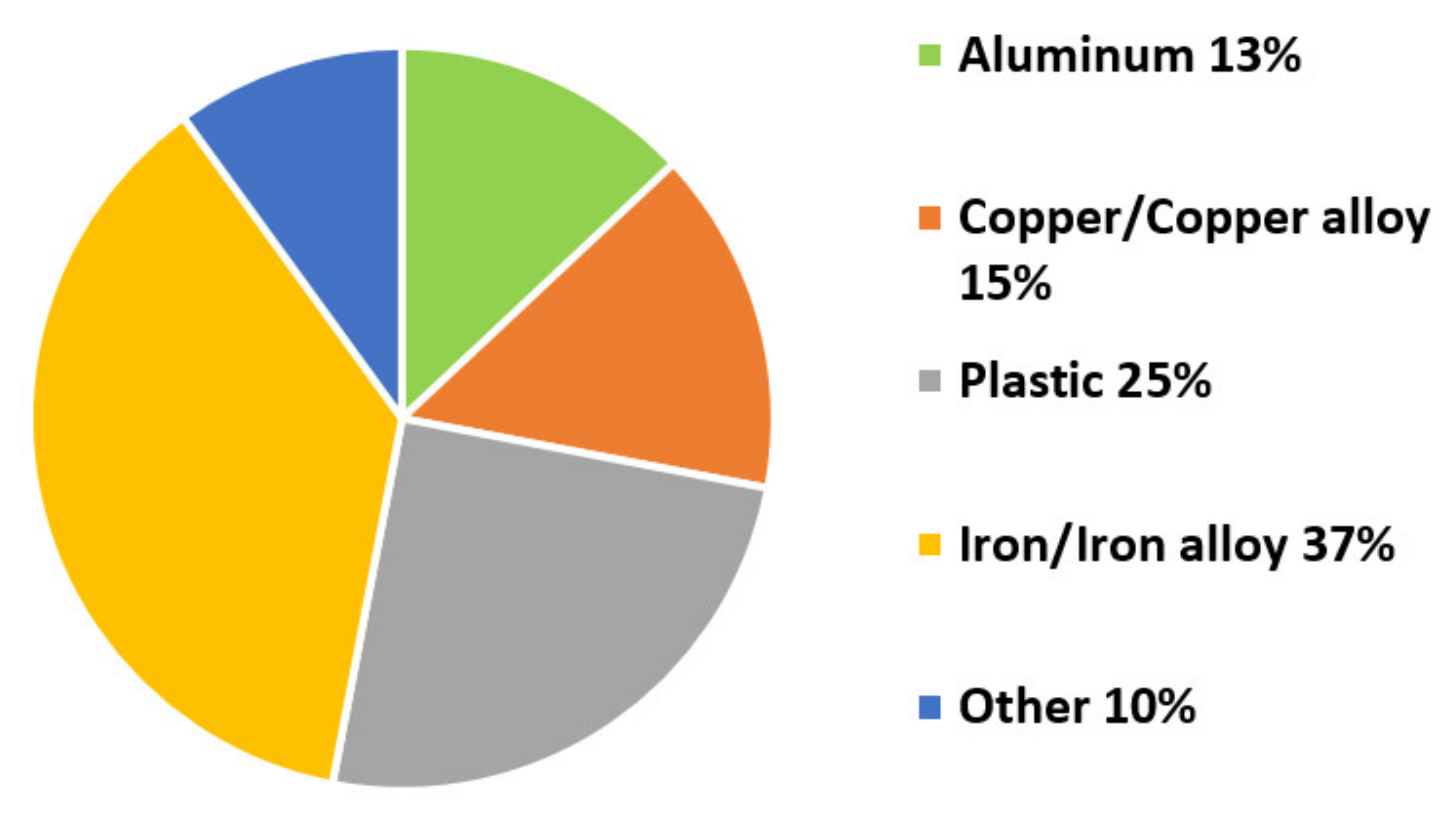
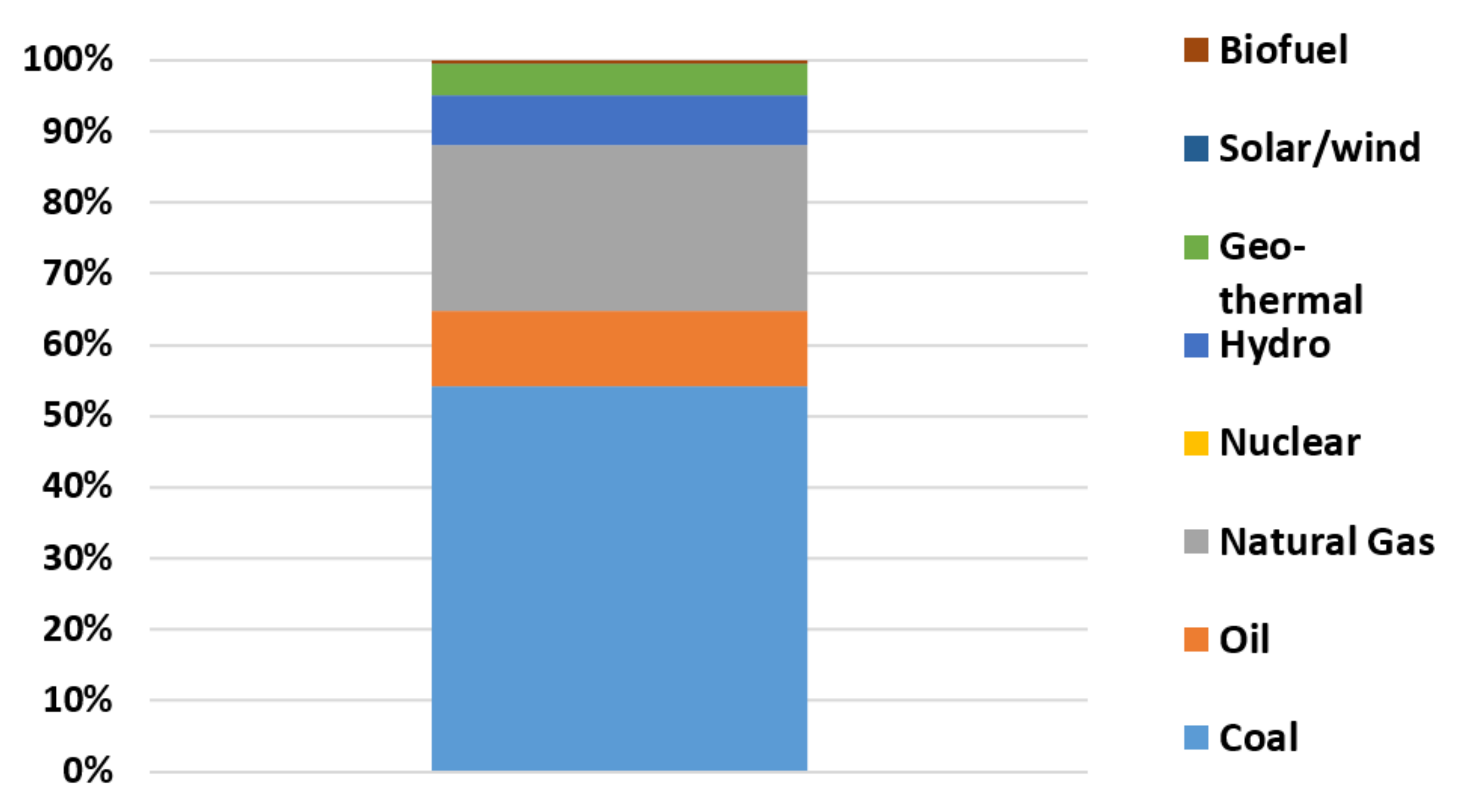
References
- World Health Organization. Available online: https://www.who.int/news-room/fact-sheets/detail/climate-change-and-health (accessed on 28 August 2019).
- Robine, J.-M.; Cheung, S.L.K.; Le Roy, S.; Van Oyen, H.; Griffiths, C.; Michel, J.-P.; Herrmann, F.R. Death toll exceeded 70,000 in Europe during the summer of 2003. Comptes Rendus Biol. 2008, 331, 171–178. [Google Scholar] [CrossRef] [PubMed]
- International Energy Agency (IEA). The Future of Cooling; IEA Publications: Paris, France, 2018. [Google Scholar]
- Turconi, R.; Boldrin, A.; Astrup, T.F. Life cycle assessment (LCA) of electricity generation technologies: Overview, comparability and limitations. Renew. Sustain. Energy Rev. 2013, 28, 555–565. [Google Scholar] [CrossRef]
- International Energy Agency (IEA). World Energy Balance 2018; IEA Publications: Paris, France, 2018. [Google Scholar]
- IMF. Available online: https://www.imf.org/external/pubs/ft/weo/2017/01/weodata/index.aspx (accessed on 28 August 2019).
- Zhang, N.; Wang, H.; Gallagher, J.; Song, Q.; Tam, V.W.; Duan, H. A dynamic analysis of the global warming potential as-sociated with air conditioning at a city scale: An empirical study in Shenzhen, China. Environ. Impact Assess. Rev. 2020, 81, 106354. [Google Scholar] [CrossRef]
- Beshr, M.; Aute, V.; Abdelaziz, O.; Fricke, B.; Radermacher, R. Potential emission savings from refrigeration and air condi-tioning systems by using low GWP refrigerants. Int. J. Life Cycle Assess. 2017, 22, 675–682. [Google Scholar] [CrossRef]
- Gheewala, S.H.; Nielsen, P.H. Central and individual air-conditioning systems—A comparison of environmental impacts and resource consumption in a life cycle perspective. Int. J. Sustain. Dev. World Ecol. 2003, 10, 149–155. [Google Scholar] [CrossRef]
- Almutairi, K.; Thoma, G.; Burek, J.; Algarni, S.; Nutter, D. Life cycle assessment and economic analysis of residential air conditioning in Saudi Arabia. Energy Build. 2015, 102, 370–379. [Google Scholar] [CrossRef]
- Liu, S.; Schulz, U.W.; Sapar, M.H.; Qian, S. Evaluation of the environmental performance of the chilled ceiling system using life cycle assessment (LCA): A case study in Singapore. Build. Environ. 2016, 102, 207–216. [Google Scholar] [CrossRef]
- Shah, V.P.; DeBella, D.C.; Ries, R.J. Life cycle assessment of residential heating and cooling systems in four regions in the United States. Energy Build. 2008, 40, 503–513. [Google Scholar] [CrossRef]
- Li, G. Investigations of life cycle climate performance and material life cycle assessment of packaged air conditioners for residential application. Sustain. Energy Technol. Assess. 2015, 11, 114–125. [Google Scholar] [CrossRef]
- Irshad, K.; Habib, K.; Algarni, S.; Saha, B.B.; Jamil, B. Sizing and life-cycle assessment of building integrated thermoelectric air cooling and photovoltaic wall system. Appl. Therm. Eng. 2019, 154, 302–314. [Google Scholar] [CrossRef]
- PRé Sustainability B.V., The Netherlands. Simapro. Available online: https://simapro.com/ (accessed on 15 January 2020).
- Ecoinvent v3 Database, Switzerland. Available online: https://www.ecoinvent.org/ (accessed on 15 January 2020).
- Inaba, A.; Itsubo, N. Preface. Int. J. Life Cycle Assess. 2018, 23, 2271–2275. [Google Scholar] [CrossRef]
- Itsubo, N.; Murakami, K.; Kuriyama, K.; Yoshida, K.; Tokimatsu, K.; Inaba, A. Development of weighting factors for G20 countries—Explore the difference in environmental awareness between developed and emerging countries. Int. J. Life Cycle Assess. 2015, 23, 2311–2326. [Google Scholar] [CrossRef]
- Murakami, K.; Itsubo, N.; Kuriyama, K.; Yoshida, K.; Tokimatsu, K. Development of weighting factors for G20 countries. Part 2: Estimation of willingness to pay and annual global damage cost. Int. J. Life Cycle Assess. 2017, 23, 2349–2364. [Google Scholar] [CrossRef]
- Huijbregts, M.A.J.; Steinmann, Z.J.N.; Elshout, P.M.F.; Stam, G.; Verones, F.; Vieira, M.; Zijp, M.; Hollander, A.; Van Zelm, R. ReCiPe2016: A harmonised life cycle impact assessment method at midpoint and endpoint level. Int. J. Life Cycle Assess. 2017, 22, 138–147. [Google Scholar] [CrossRef]
- Bulle, C.; Margni, M.; Patouillard, L.; Boulay, A.-M.; Bourgault, G.; De Bruille, V.; Cao, V.; Hauschild, M.; Henderson, A.; Humbert, S.; et al. IMPACT World+: A globally regionalized life cycle impact assessment method. Int. J. Life Cycle Assess. 2019, 24, 1653–1674. [Google Scholar] [CrossRef]
- Tang, L.; Ii, R.; Tokimatsu, K.; Itsubo, N. Development of human health damage factors related to CO2 emissions by con-sidering future socioeconomic scenarios. Int. J. Life Cycle Assess 2018, 23, 2288–2299. [Google Scholar] [CrossRef]
- Tang, L.; Higa, M.; Tanaka, N.; Itsubo, N. Assessment of global warming impact on biodiversity using the extinction risk index in LCIA: A case study of Japanese plant species. Int. J. Life Cycle Assess. 2017, 23, 314–323. [Google Scholar] [CrossRef]
- Tang, L.; Nagashima, T.; Hasegawa, K.; Ohara, T.; Sudo, K.; Itsubo, N. Development of human health damage factors for PM2.5 based on a global chemical transport model. Int. J. Life Cycle Assess. 2018, 23, 2300–2310. [Google Scholar] [CrossRef]
- Tang, L.; Nagashima, T.; Hasegawa, K.; Ohara, T.; Sudo, K.; Itsubo, N. Development of human health damage factors for tropospheric ozone considering transboundary transport on a global scale. Int. J. Life Cycle Assess. 2015, 23, 2339–2348. [Google Scholar] [CrossRef]
- Motoshita, M.; Ono, Y.; Pfister, S.; Boulay, A.; Berger, M.; Nansai, K.; Tahara, K.; Itsubo, N.; Inaba, A. Consistent charac-terisation factors at midpoint and endpoint relevant to agricultural water scarcity arising from freshwater consumption. Int. J. Life Cycle Assess. 2014, 23, 2276–2287. [Google Scholar] [CrossRef]
- Kuwayama, T.; Yamaguchi, K.; Okada, K.; Kikegawa, Y.; Kanda, M.; Varquez, A.C.G.; Darmanto, N.S.; Darmanto, P.S.; Ihara, T. Reduction Effect of DALY of Sleep Disturbance and Fatigue by Air Conditioner Evaluation in Jakarta, Indonesia. J. Life Cycle Assess. Jpn. 2019, 15, 2–9. [Google Scholar] [CrossRef]
- EIA. Petroleum and Other Liquids Reserves. Available online: https://www.eia.gov/international/data/world/petroleum-and-other-liquids/annual-crude-and-lease-condensate-reserves?pd=5&p=0000000000000000000008&u=0&f=A&v=mapbubble&a=-&i=none&vo=value&t=C&g=00000000000000000000000000000000000000000000000001&l=249-ruvvvvvfvtvnvv1vrvvvvfvvvvvvfvvvou20evvvvvvvvvvnvvvs0008&s=315532800000&e=1577836800000& (accessed on 30 December 2020).
- Ihara, T.; Kikegawa, Y.; Asahi, K.; Genchi, Y.; Kondo, H. Changes in year-round air temperature and annual energy consumption in office building areas by urban heat-island countermeasures and energy-saving measures. Appl. Energy 2008, 85, 12–25. [Google Scholar] [CrossRef]
- Fukuda, S.; Ihara, T.; Genchi, Y.; Narumi, D. Japanese sleep disturbance and fatigue disability weights in evaluating the effects of increasing temperatures on health by a life cycle approach. Int. J. Life Cycle Assess. 2013, 18, 1089–1097. [Google Scholar] [CrossRef]
- LCA-Forum. Available online: https://lca-forum.org/english/pdf/No12_Summary.pdf (accessed on 28 August 2019).
- Intergovernmental Panel on Climate Change (IPCC). Available online: https://www.ipcc-nggip.iges.or.jp/public/kpsg/ (accessed on 28 August 2019).
- World Health Organization (WHO). Available online: https://www.who.int/phe/health_topics/outdoorair/databases/en/ (accessed on 28 August 2019).
- Santamouris, M. Cooling the buildings—past, present and future. Energy Build. 2016, 128, 617–638. [Google Scholar] [CrossRef]
- Indonesia Energy Council (DEN). Available online: https://www.esdm.go.id/assets/media/content/content-indonesia-energy-outlook-2019-english-version.pdf (accessed on 10 December 2020).
- Karkour, S.; Ichisugi, Y.; Abeynayaka, A.; Itsubo, N. External-Cost Estimation of Electricity Generation in G20 Countries: Case Study Using a Global Life-Cycle Impact-Assessment Method. Sustainability 2020, 12, 2002. [Google Scholar] [CrossRef]
- IDEAv2. Available online: http://idea-lca.com/?lang=en (accessed on 28 August 2019).
- Graedel, T.; Harper, E.M.; Nassar, N.T.; Nuss, P.; Reck, B.K. Criticality of metals and metalloids. Proc. Natl. Acad. Sci. USA 2015, 112, 4257–4262. [Google Scholar] [CrossRef]
- Zhao, L.; Zeng, W.; Yuan, Z. Reduction of potential greenhouse gas emissions of room air-conditioner refrigerants: A life cycle carbon footprint analysis. J. Clean. Prod. 2015, 100, 262–268. [Google Scholar] [CrossRef]
- Hasegawa, T.; Park, C.; Fujimori, S.; Takahashi, K.; Hijioka, Y.; Masui, T. Quantifying the economic impact of changes in energy demand for space heating and cooling systems under varying climatic scenarios. Palgrave Commun. 2016, 2, 16013. [Google Scholar] [CrossRef]
- De Cian, E.; Pavanello, F.; Randazzo, T.; Mistry, M.N.; Davide, M. Households’ adaptation in a warming climate. Air con-ditioning and thermal insulation choices. Environ. Sci. Policy 2019, 100, 136–157. [Google Scholar] [CrossRef]
- McLinden, M.O.; Brown, J.S.; Brignoli, R.; Kazakov, A.F.; Domanski, P.A. Limited options for low-global-warming-potential refrigerants. Nat. Commun. 2017, 8, 14476. [Google Scholar] [CrossRef]
- Hashimoto, M.; Otsuka, T.; Fukushima, M.; Okamoto, H.; Hayamizu, H.; Ueno, K.; Akasaka, R. Development of New Low-GWP Refrigerants–Refrigerant Mixtures Including HFO-1123. Sci. Technol. Built Environ. 2019, 25, 776–783. [Google Scholar] [CrossRef]
- Ciconkov, R. Refrigerants: There is still no vision for sustainable solutions. Int. J. Refrig. 2018, 86, 441–448. [Google Scholar] [CrossRef]


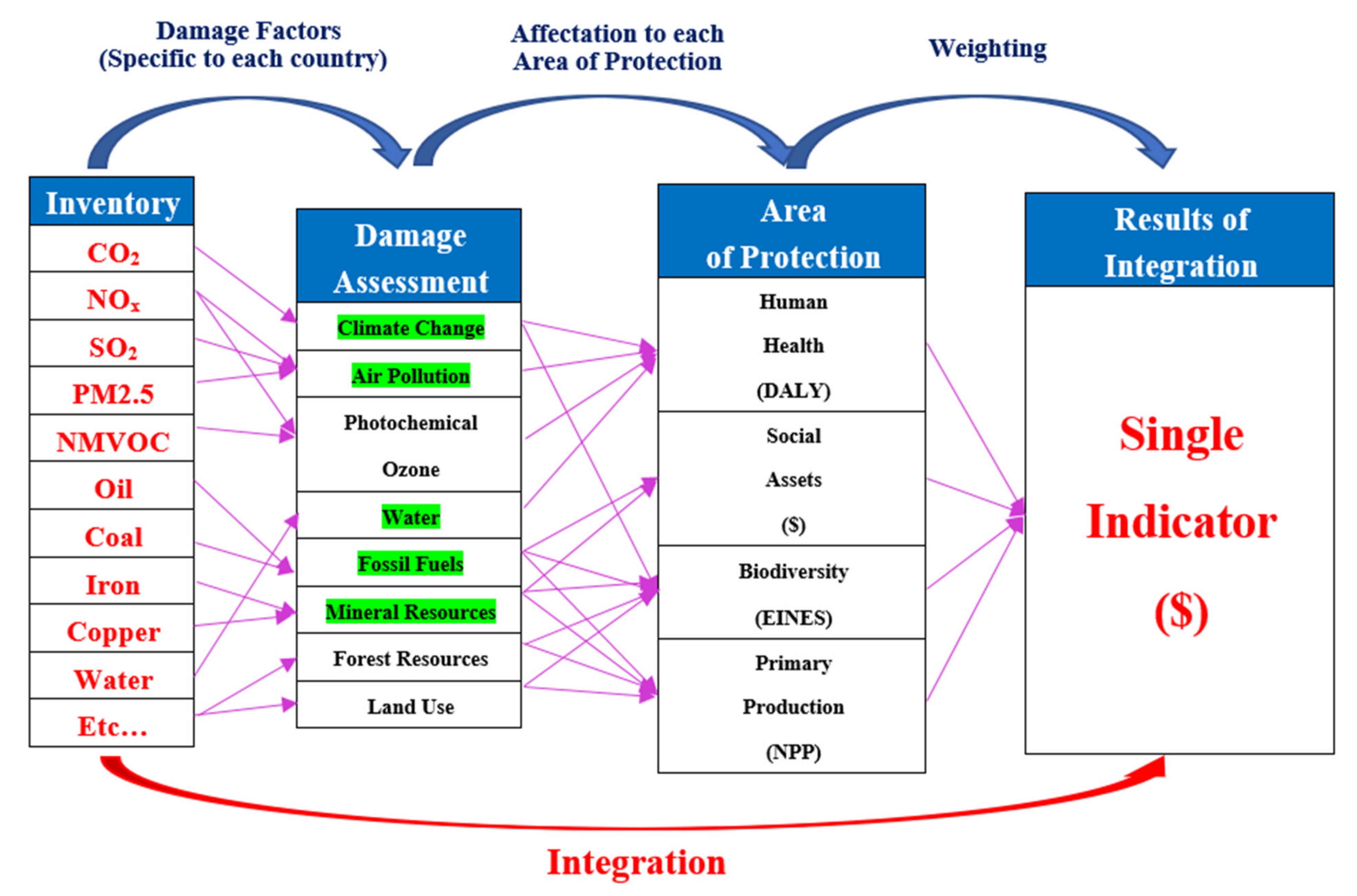
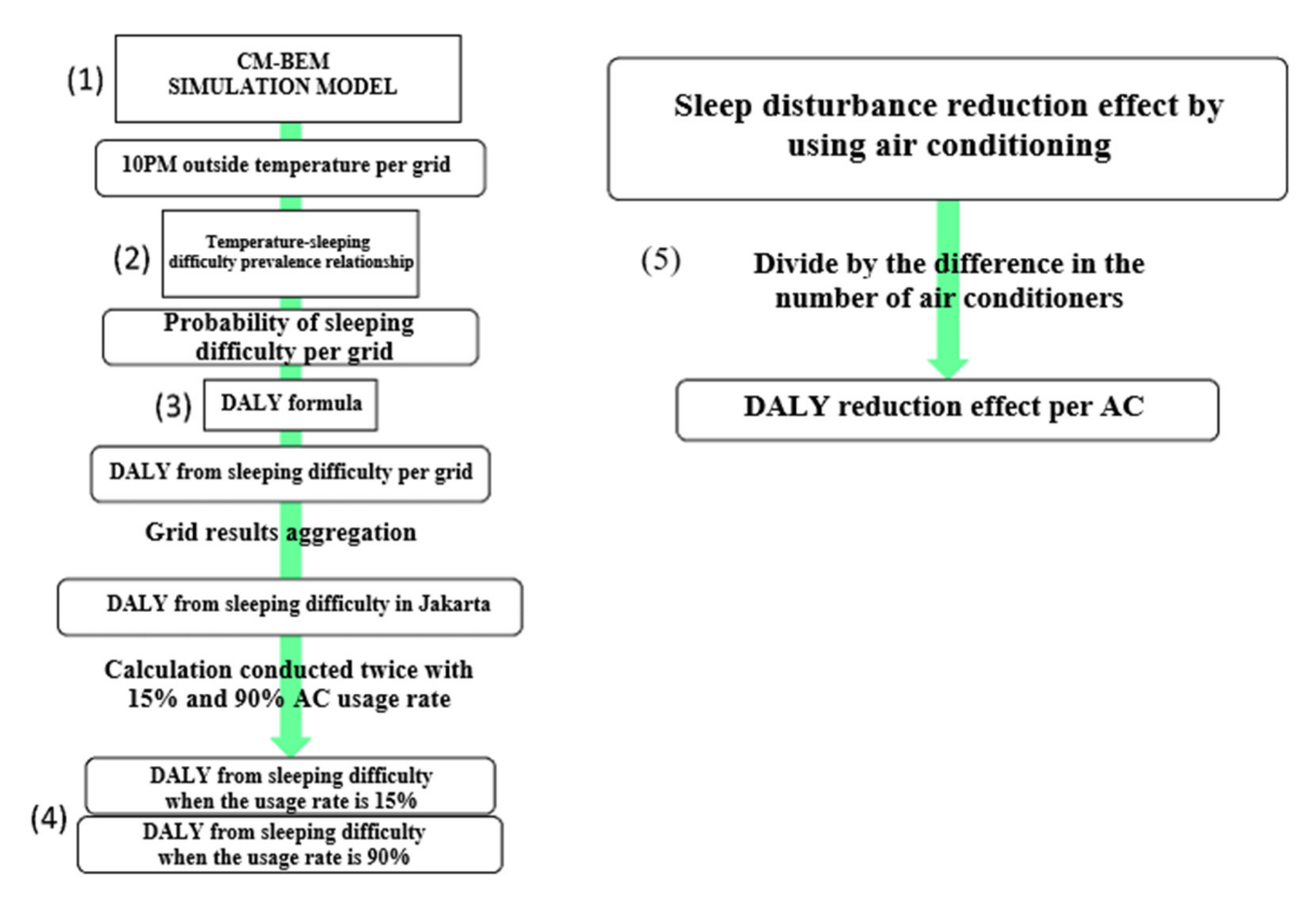
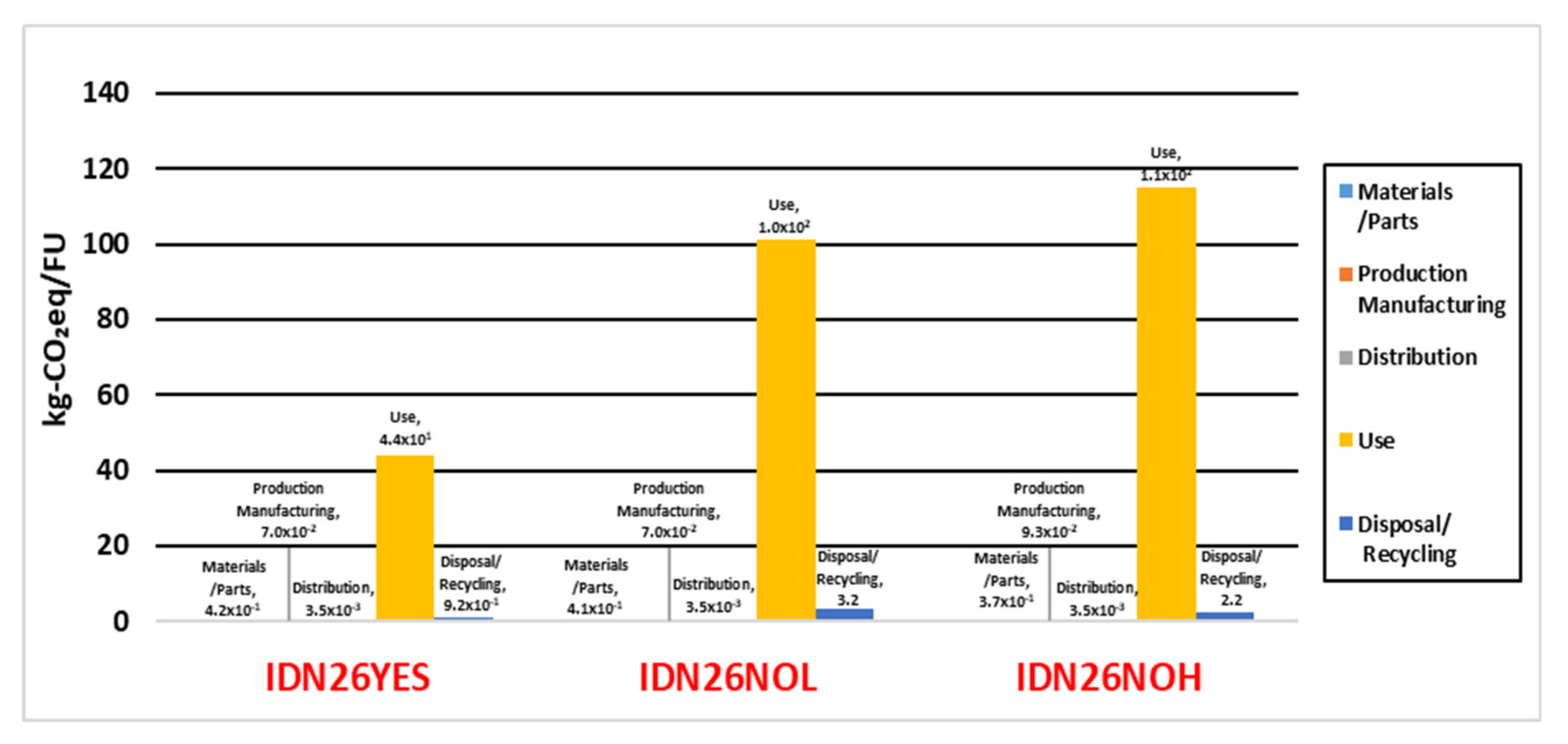

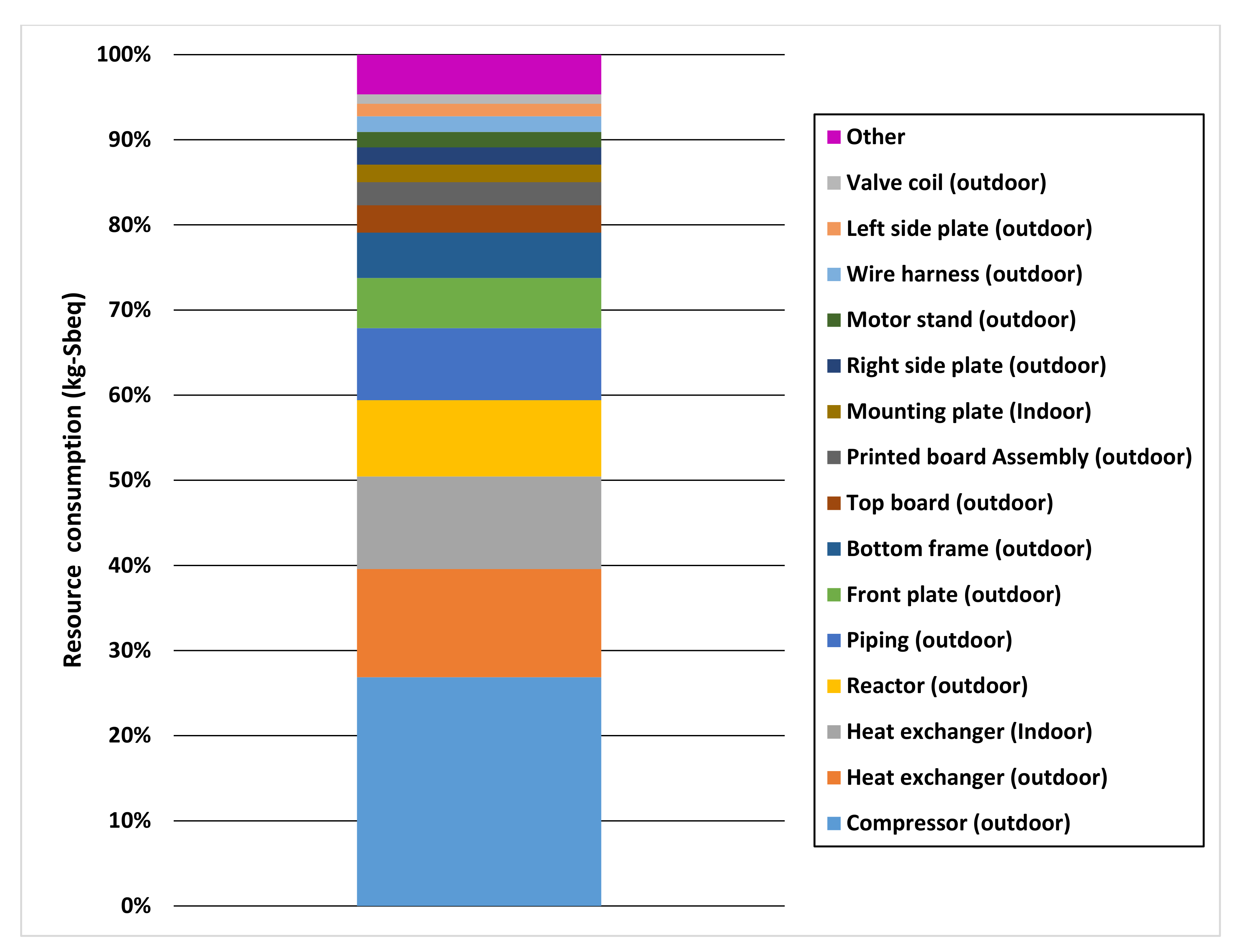


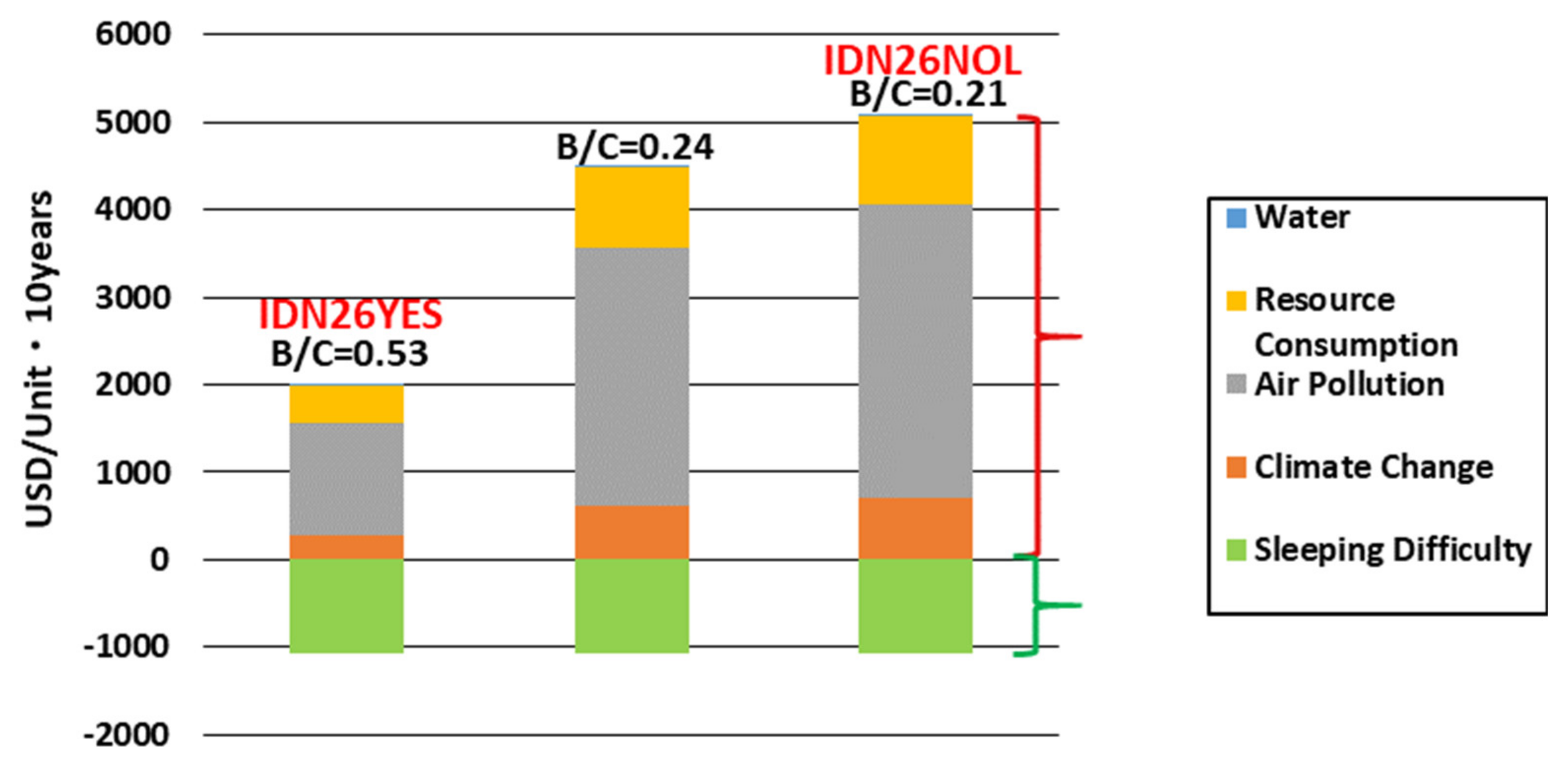
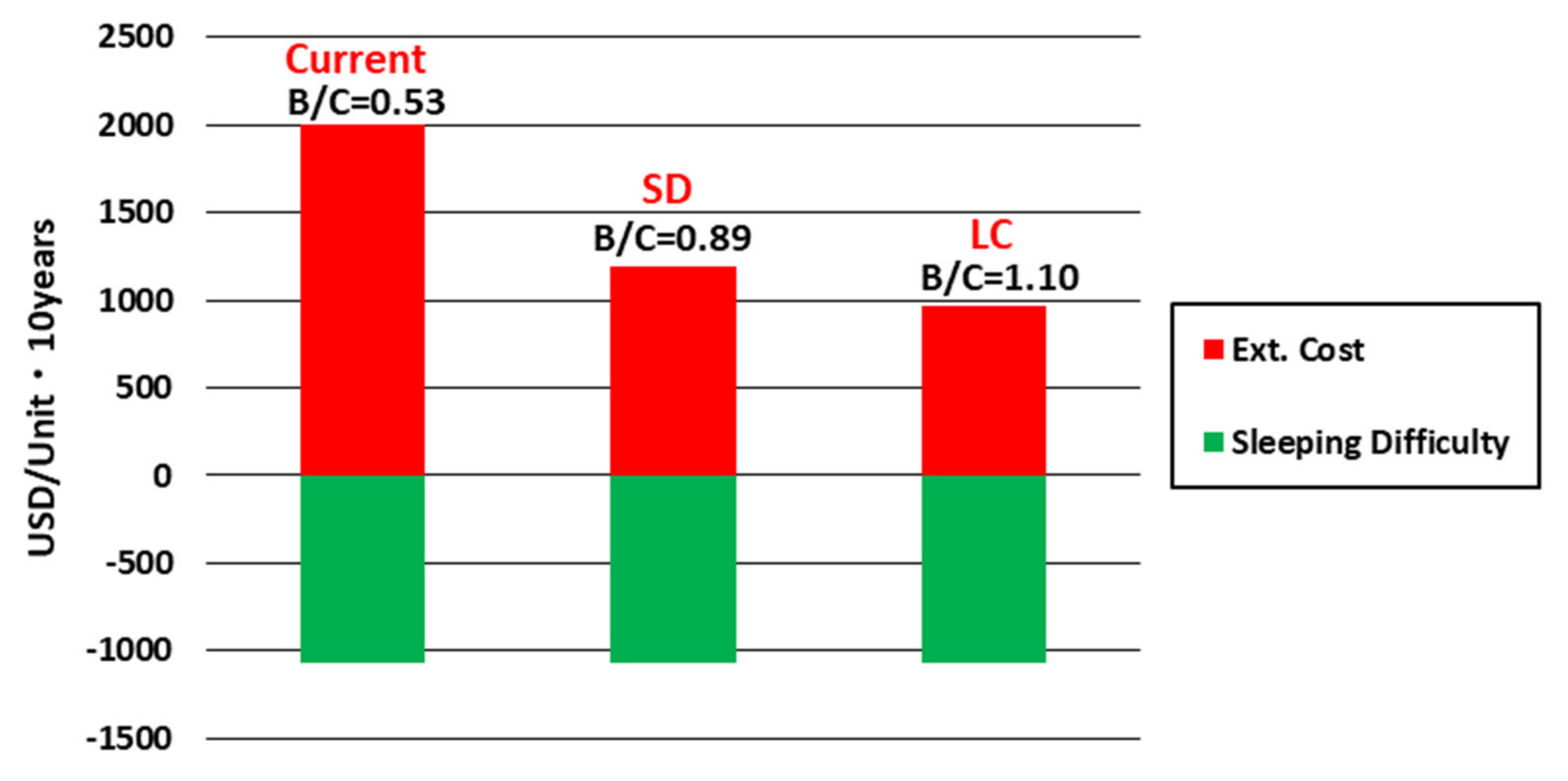
| Model Name | |||
|---|---|---|---|
| Parameter | IDN26YES | IDN26NOH | IDN26NOL |
| Inverter | YES | NO | NO |
| Refrigerant | R32 | R32 | R410A |
| Cooling Capacity (kW) | 2.6 | 2.6 | 2.6 |
| Weight (kg) | 43 | 42 | 40 |
| Yearly operating time (h) | 4400 | 4400 | 4400 |
| 10-year electricity consumption (kWh) | 13,780 | 31,770 | 36,030 |
Publisher’s Note: MDPI stays neutral with regard to jurisdictional claims in published maps and institutional affiliations. |
© 2021 by the authors. Licensee MDPI, Basel, Switzerland. This article is an open access article distributed under the terms and conditions of the Creative Commons Attribution (CC BY) license (http://creativecommons.org/licenses/by/4.0/).
Share and Cite
Karkour, S.; Ihara, T.; Kuwayama, T.; Yamaguchi, K.; Itsubo, N. Life Cycle Assessment of Residential Air Conditioners Considering the Benefits of Their Use: A Case Study in Indonesia. Energies 2021, 14, 447. https://doi.org/10.3390/en14020447
Karkour S, Ihara T, Kuwayama T, Yamaguchi K, Itsubo N. Life Cycle Assessment of Residential Air Conditioners Considering the Benefits of Their Use: A Case Study in Indonesia. Energies. 2021; 14(2):447. https://doi.org/10.3390/en14020447
Chicago/Turabian StyleKarkour, Selim, Tomohiko Ihara, Tadahiro Kuwayama, Kazuki Yamaguchi, and Norihiro Itsubo. 2021. "Life Cycle Assessment of Residential Air Conditioners Considering the Benefits of Their Use: A Case Study in Indonesia" Energies 14, no. 2: 447. https://doi.org/10.3390/en14020447
APA StyleKarkour, S., Ihara, T., Kuwayama, T., Yamaguchi, K., & Itsubo, N. (2021). Life Cycle Assessment of Residential Air Conditioners Considering the Benefits of Their Use: A Case Study in Indonesia. Energies, 14(2), 447. https://doi.org/10.3390/en14020447





